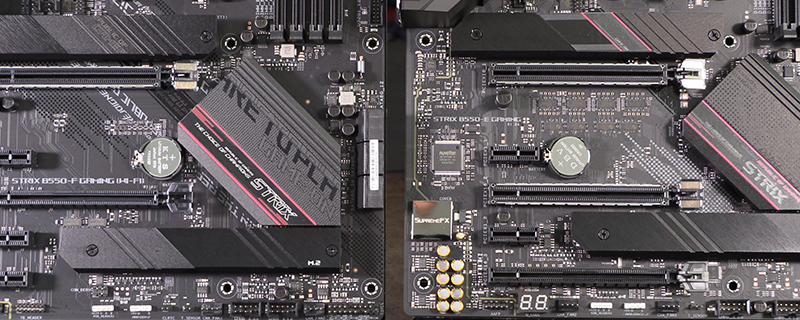ASUS ROG Strix B550-F Gaming WiFi and Strix-E Review
Conclusion
We spent a lot of time in the early pages of this review going over the ways in which the ASUS ROG Strix B550-F and B550-E are surprisingly different for two models just a letter apart in their nomenclature. Our time with them only emphasised how they feel quite apart from each other. We understand that feeling is a nebulous concept and without experience of all eight of our B550 launch motherboards they appear, in raw benchmark terms at least, too similar to be called different. Let us try and explain.
We’ll start with the simplest option, the Strix B550-E. It’s a Strix motherboard. The fact that almost nothing else needs to be said shows how powerful the Strix brand has become in the minds of both the public and those of us who have to test and write about them. When we think of the Republic Of Gamers brand we have certain expectations both in terms of their ease of use and performance capabilities, and the Strix-E meet those easily. It was a joy to use, the BIOS was up to ASUS usual high standards and we attained the highest – albeit by a literal handful of Megahertz – overclock on our Ryzen 9 3900X amongst the B550 models we’ve tested for launch. It’s the Ronseal motherboard. To paraphrase their famous tagline if you want a ROG motherboard that performs like a champ and has the results to back up the big CPUz then the ASUS ROG Strix B550-E is that motherboard. It’s fully featured, you get lots of toys in the box to play with, the lighting is good, it’s exactly what products with the legendary ROG eye on the box should be. There are loads of fan headers to sit alongside more mundane but necessary things such as armoured slots. There are more than enough high speed USB ports for even the most demanding user, and with three full length PCI Express slots – one 4.0, two 3.0 – those of you with a lot of add-in cards will be sated too.
In a lot of ways the Strix B550-F is more what we expected to see from a B550 motherboard before we began our testing. It’s a cut down X570. Yes the E is a cut down version of the big Zen architecture board too, but the Strix-F feels those losses a little more heavily. The design of the chipset cooler, a tiny thing that is utterly inconsequential, shows that this is aimed at a slightly different audience. The B550-E is hardly austere, but the F is a little more overt about it’s flash. A bit more nouveau riche to the old money of the E. There is a little less cooling from the number of fan headers, a little less power in the power stage, a little less fewer high bandwidth USB ports, a bit more bare PCB. Normally we wouldn’t mind but it was the first, albeit not the only, B550 motherboard we tested that didn’t maximise the overclocking potential of our Ryzen 9 3900X. No, 4.34 GHz isn’t exactly sluggish on twelve cores, but it’s a tiny bit disappointing, particularly for a ROG board. The one place we’re really cross about is the hiding of the VRM temperatures. They aren’t available to be viewed in any of the monitoring software we have, nor even in the BIOS. ASUS have consistently been the only manufacturer to ever choose to hide their VRM temperatures and to be honest we have no idea at all why they choose to do this, particularly as the Strix-E happily lets you see them.Â
In the end that’s what this comparison between the two comes down to. We’ve spoken a lot in our B550 reviews about what you’re compromising going for the AMD B550 chipset instead of the full fat X570. With the Strix B550-E it doesn’t feel like you’re going to give up much to get this particular PCB in your system. The Strix-F on the other hand you notice those little changes a little more acutely. They gradually add up until you have a motherboard we know we’d spend a lot of time looking at wishing we’d spent a little more for the E. Don’t get us wrong, they’re both great motherboards and demonstrate how far the technology has come at bringing consistent performance almost regardless of how much you spend. If the old adage about looking at your monitor not your case holds up, then the Strix-F will be more than adequate. The Strix-E is the one we’d take to the ball though. It just seems like you’re giving up less. It’s also pretty clear Asus are not that bothered about the Strix-F – even their own software doesn’t show the VRM temps, this in itself is quite sad because there is very little between the boards in that respect but we here at OC3D think if you’re buying a motherboard you should, if you need or want to be able to monitor the temperatures on critical components like the VRM’s. We have said it before, we will probably say it again. Asus just don’t seem to care about it.
The ASUS ROG Strix B550-F Gaming WiFi has a lot to recommend it, but is just lacking those fine details that separate the great from the good. No VRM temps on a board of this calibre in 2020 is just not going to cut the mustard anymore. If your own software doesn’t show it then in our eyes you decided that you didn’t want them to be shown. Thankfully the ROG Strix B550-E is everything you would expect from a ROG motherboard, with high performance and plenty of connectivity and VRM temps. Have we said that enough yet?
Â
Strix B550-E
Â
Strix B550-F – No VRM temps. No award. Please. Try. Harder.
Â
Discuss the ASUS ROG Strix B550-F and B550-E on the OC3D Forums.
Â
Videos




